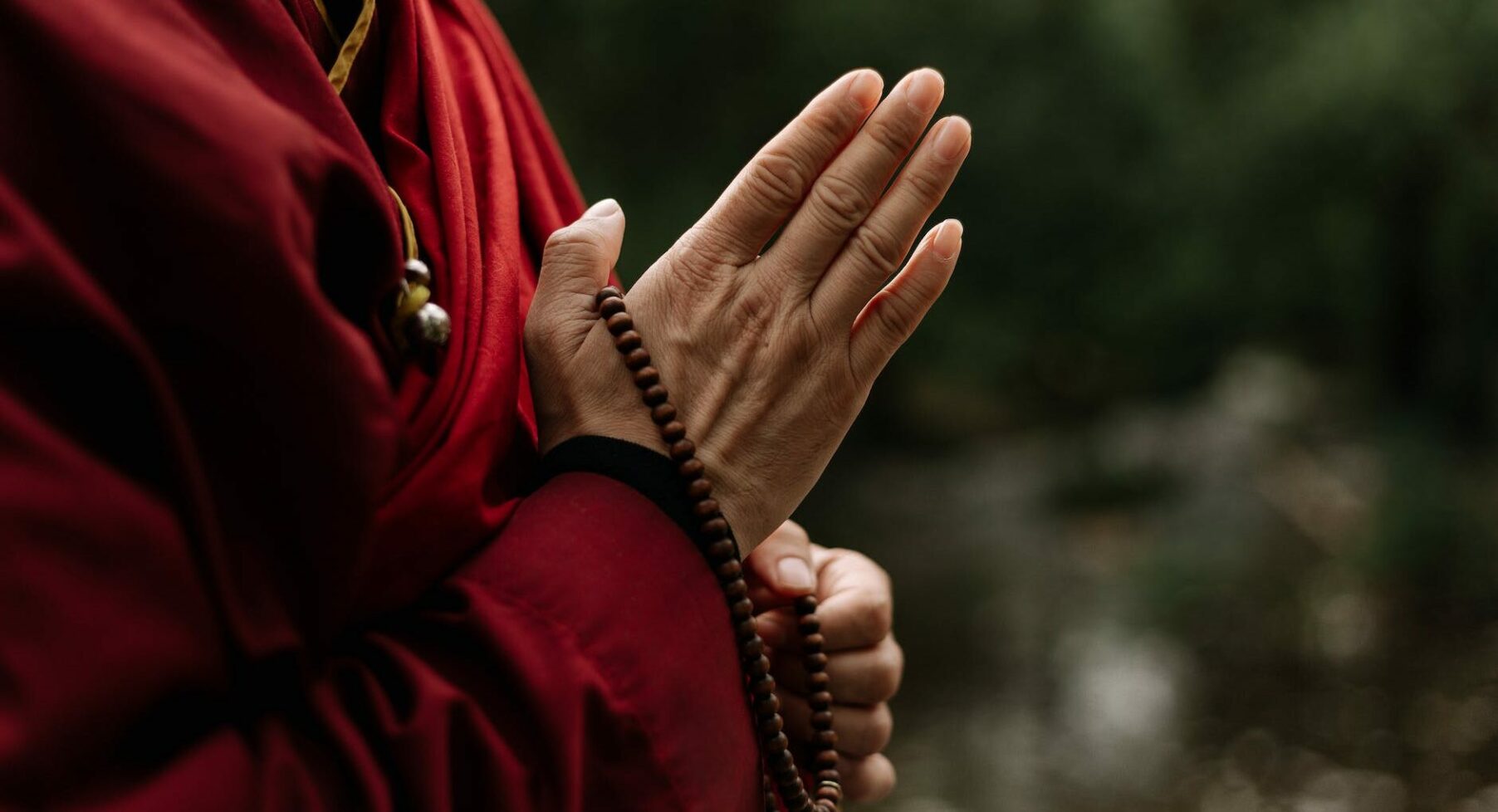There are tons of meditation and ritual accessories worldwide, and they come in all shapes and sizes. You have Tibetan Singing Bowls, religious statues, flutes, wind chimes, incense, Buddhist prayer beads, and beaded mala. Among all these, prayer beads, beaded mala, and beaded wrist mala are among the most widespread, simplest, and most popular. After all, you need a bead with significance and some thread to make this religious/spiritual accessory.
This also means that beads, beaded mala, and beaded wrist mala are one of the oldest, if not the oldest, ritual/spiritual accessories. Beads have played an extremely important part in our human history. They have been used as Buddhist prayer beads, decorative objects, objects for beaded mala, and talismans. Bead is, in fact, extremely simple. All you need is a roundish solid object, and you got yourself a bead. Now attach a bit of significance to that object, relate it to a deity, and you got yourself a prayer bead.
While everyone agrees that beads are among some of the oldest human religious and fashion accessories, what about prayer beads? Surely primitive humans would not use beads in the form of prayer beads, right?
History of Prayer Beads
This is a murky topic as nobody can say for sure when the oldest form of prayer bead appeared. Since prayer beads are usually a part of everyday life, it is hard to find written records. In addition, without a written or vocal tradition, it is hard to separate ancient prayer beads from random rocks, seeds, and stones when seeking the history of Mala Beads. The only exception to this is the carved prayer beads.
The point is because prayer beads could be anything, it is hard to find historical records. That said, there are a few written texts, vocal traditions, and records that we can take as some form of history.
So without any further ado, let’s get started.
1) Ancient Record
One of the oldest images of a beaded necklace comes from ancient Greece. This image goes back to roughly the 17th century BC, give or take a few tens of years. This is roughly around 3722 years back in the past. Since Greek Myth is filled with many Gods and Goddesses, it should not be surprising that the ancient Greeks used prayer beads as a religious accessory. In addition to this, given that Greek Gods are known for their human-like behaviors, including their desire for appreciation, this historical evidence also makes logical sense.
Another old evidence of people using prayer beads is in the ancient city of Chania-Daro of the Indus valley civilization, which is said to be habituated roughly around the 40th to 17th century BCE. Archaeologists discovered an entire bead-making factor in the remains of this city. That said, it is hard to tell if the beads, beaded mala, and beaded wrist mala found here were meant as jewelry or ritualistic accessories. It is not completely impossible that some of the beads from this factory were used as prayer beads. If this is true, prayer beads have existed for more than 3722 years and possibly even 6022 years into the past.
2) Buddhist canon
As we mentioned, historical records of prayer beads are hard to find. So although Greeks and Indus valley civilization might have used prayer beads, there remains some room for doubt. However, a Buddhist text is dated and specifically mentions beads for prayer.
A Buddhist canon from the fourth century known as Mokugenji Sutra states an interesting story about a king and Gautama Buddha that has this mentioned. It states:
The Story
King Virudhaka sought Lord Buddha to seek his/ Buddhist teaching and a way by which method from where he could share the Lord’s Wisdom. To this lord, Buddha replied “King, if you want to eliminate earthy desires and end their suffering, make a circular string of 108 beads made from the seeds of Mokugenji. Hold it always to yourself. Recite Namo Dharma – Namo Buddha – Namo Sangha, count bead with each recitation.”
His words essentially mean make a 108 beaded mala filled with prayer beads from the Goldenrain Tree and chant the three mantras of Namo Dharma – Namo Buddha – Namo Sangha with each count of prayer beads.
This text is from the 4th century, roughly 1722 years back. And, if this text is to be believed, it was lord Gautama Buddha who said this. Since Lord Buddha was said to be from 560BCE and 483BCE, prayer beads are at least 2502 years old.
For those who are wondering about the meaning behind the Japa Mantra, their rough translations are:
- Namo/Namas: Devote yourself
- Buddha: Awakened one
- Dharma: Right way of living/ Cosmic Order
- Sangha: Community
So these mantas essentially boil down to devoting yourself to yourself, the awakened ones and your society.
3) Hindu Text
The Vedic scriptures are Hindu Scriptures that date back to approximately date back to 12th century BCE. Although the mentions of prayer beads are not exactly as open, they do mention that 103 prayer beads were used during the Treta Yuga (the second cycle), 108 beads during Draper Yuga (the cycle before the current one), and 109 beads during Kali Yuga (current cycle of life).
Since there were already traces of beaded Malas back in the Indus valley civilizations who worshipped a mix of semi-Hinduism, Jainism, and Buddhism, it should not be a surprise that prayer beads can exist during the period of Veda.
Significance in 108 Buddhism
The last historical evidence of prayer beads says that Lord buddha mentioned using 108 beads. Why did he say 108 number in specific? As per Buddhism, it is believed that the road to Nirvana is filled with 108 temptations. If you manage to overcome all of the 108 temptations and 108 human passions, then finally, you can reach Nirvana.
Besides this, the number 108 is also considered as:
- Unity and wholeness of existence
- Number of Chakra Channels converging from the heart chakra
- Sacred Books
- A number of images of lord buddha and more.
Additionally, the importance of 108 also spans Sanskrit words. In Sanskrit, there are 54 letters with masculine and feminine forms for each letter. As such, Sanskrit words, also known as the language of gods, has 108 letters.
Modern Use of Prayer Beads
As per the karmic cycle in Hinduism, we are currently in the Kali Yuga, also known as the dark age and the last phase in the karmic cycle. As such, it is believed that this is the age of war and diminishing beliefs. It should not be surprising that many people of this cycle have lost their connection with the spiritual self. That said, many people still are doing their best to do good in the world and reach Nirvana. Like beaded mala used for meditation, Prayer beads are still also used for Buddhist practices in meditation, just like how they were used to gain enlightenment in the past.
Furthermore, despite the decrease in meditational and Buddhist practices, prayer beads and beaded mala are still widely used as decor and fashion accessories.
In the end
Beads and beaded accessories have been around for as long as humans have. They are simple to make, good to look at, and their materials are easy to find. That said, the history of mala beads being used as prayer beads is debatable. There is slight evidence of them being used in the Indus valley civilization and by ancient Greeks. At the same time, a fourth-century text directly states that lord buddha said to use 108 beaded mala for prayer.
Regardless of the correct estimated date from where beads were first used as prayer beads, they have been around for a long time. The mystery behind prayer beads is just as intriguing as the prayer beads themselves.
We hope you found this interesting. And as always, thank you for reading till the end.

